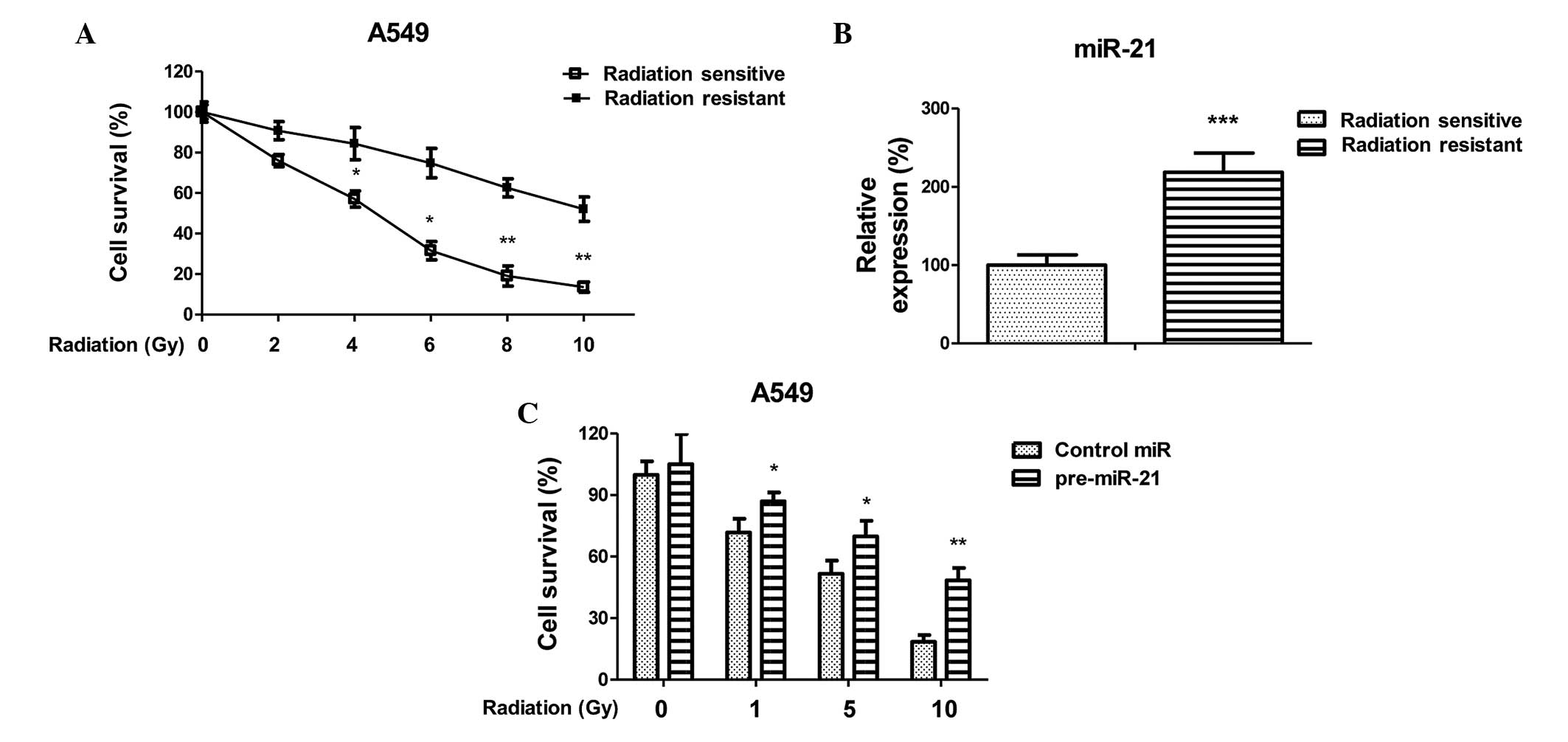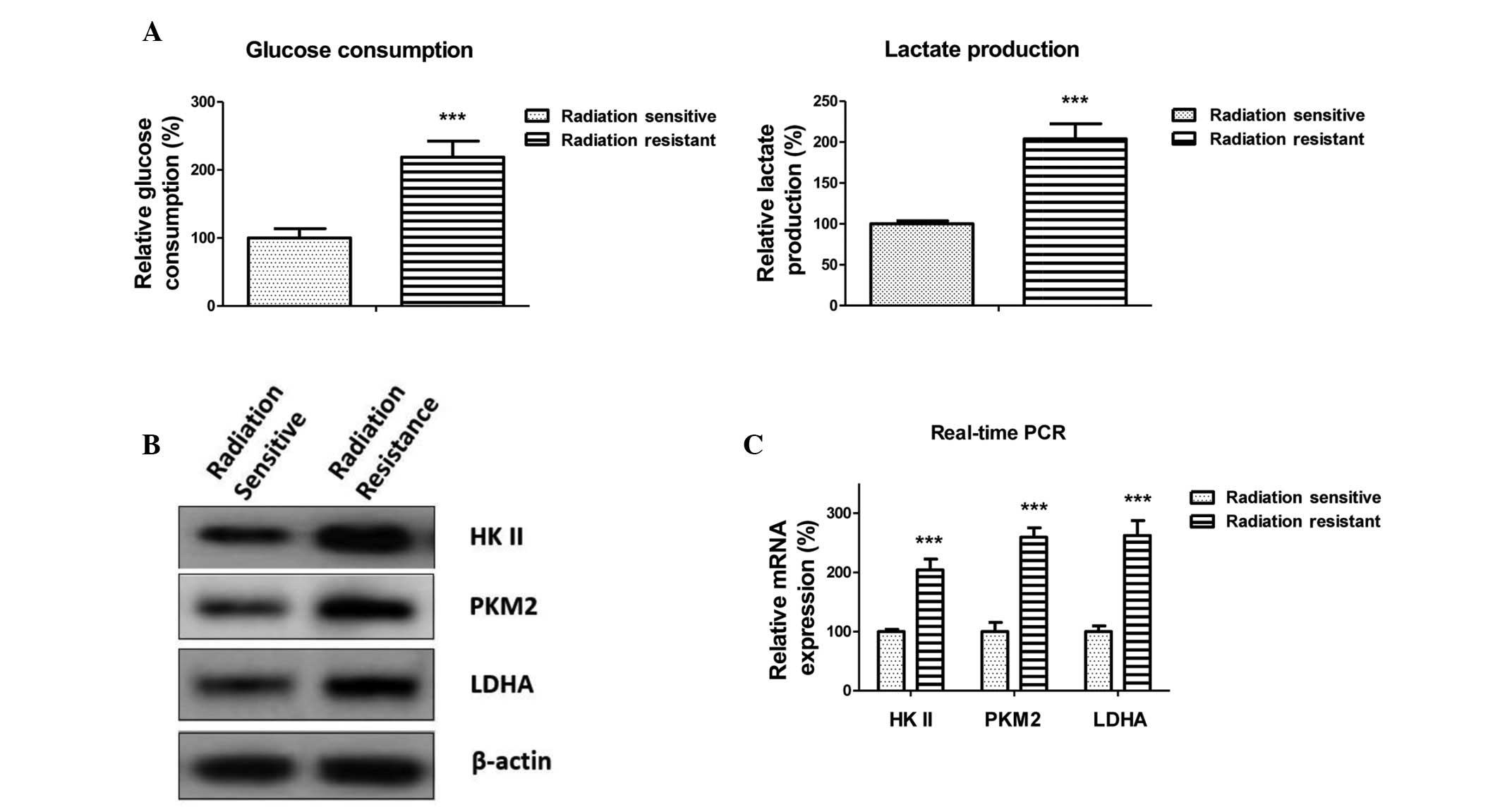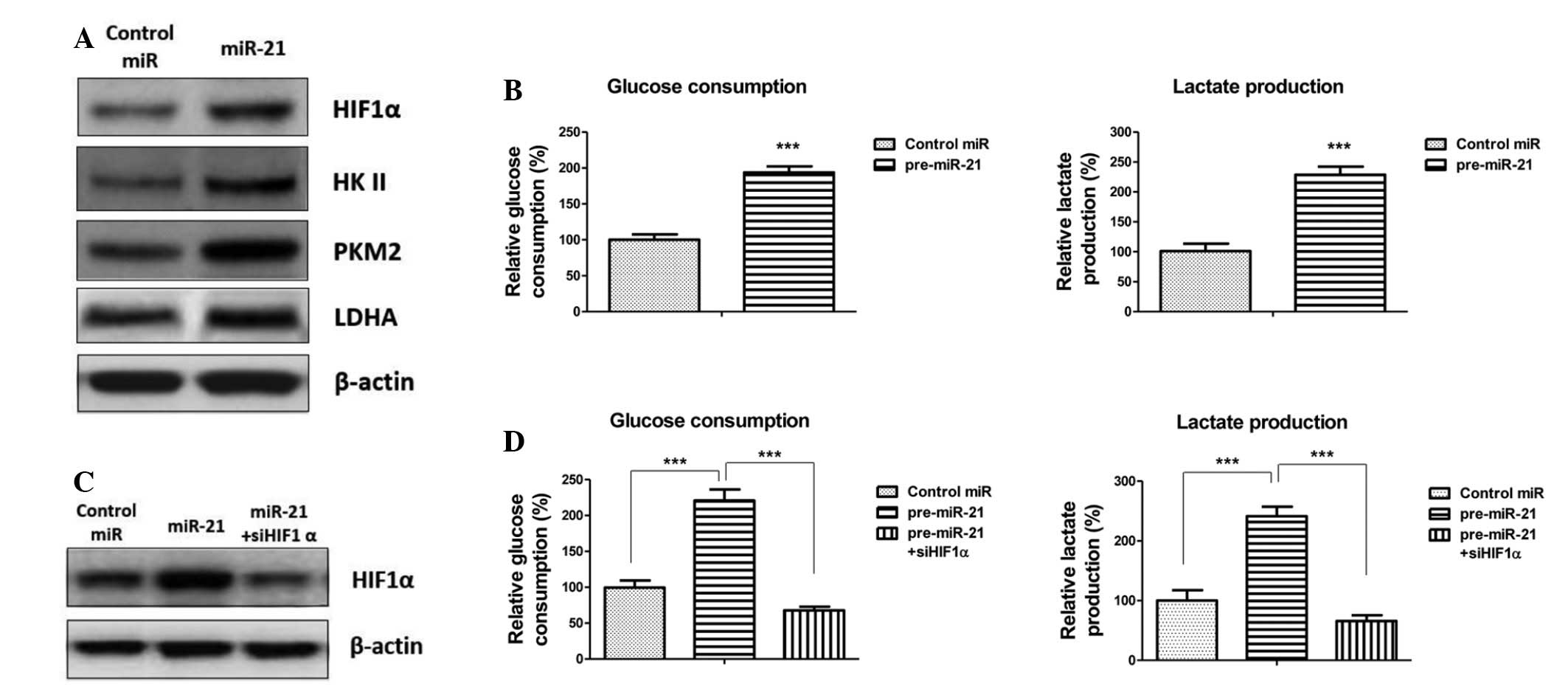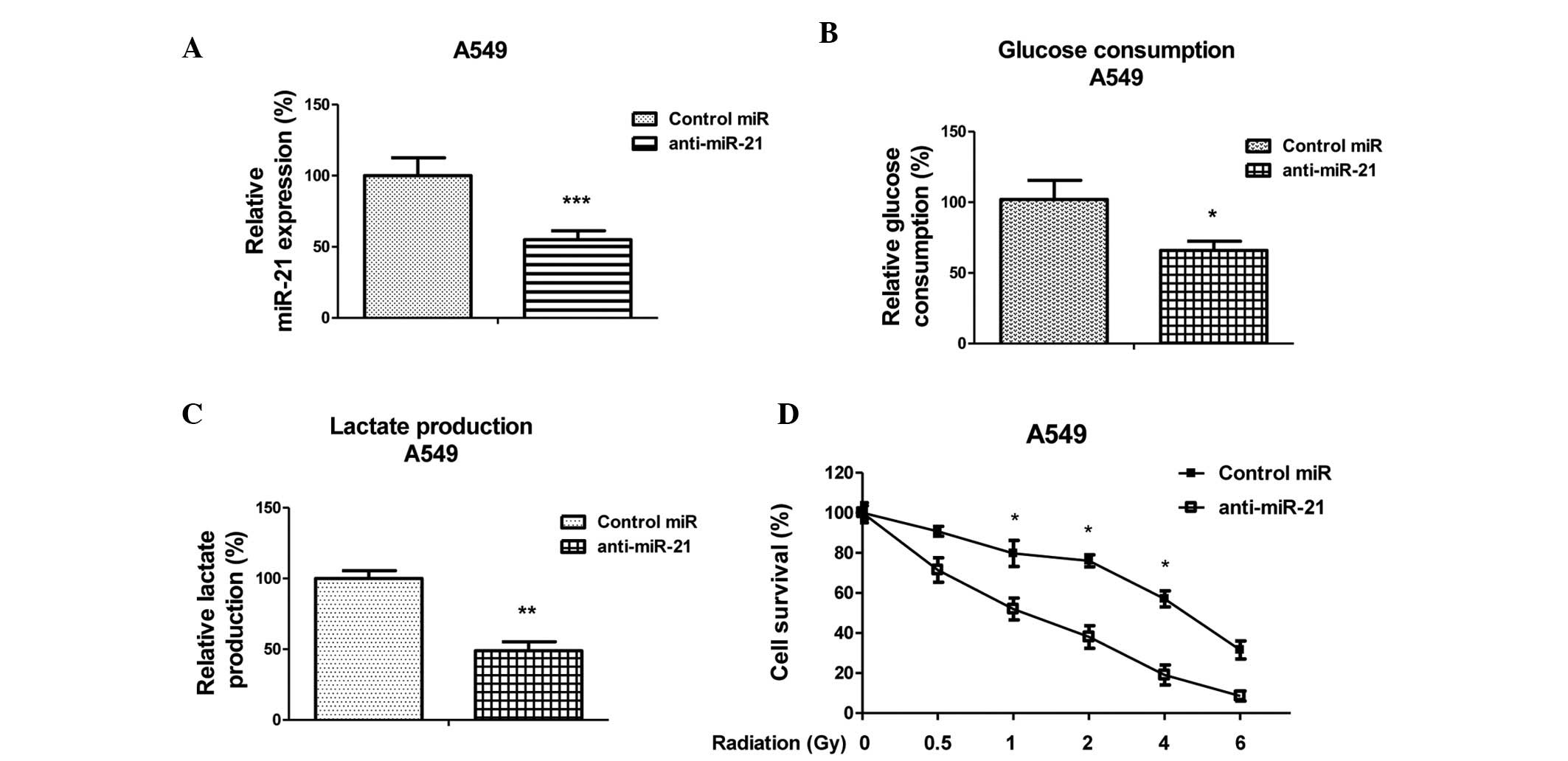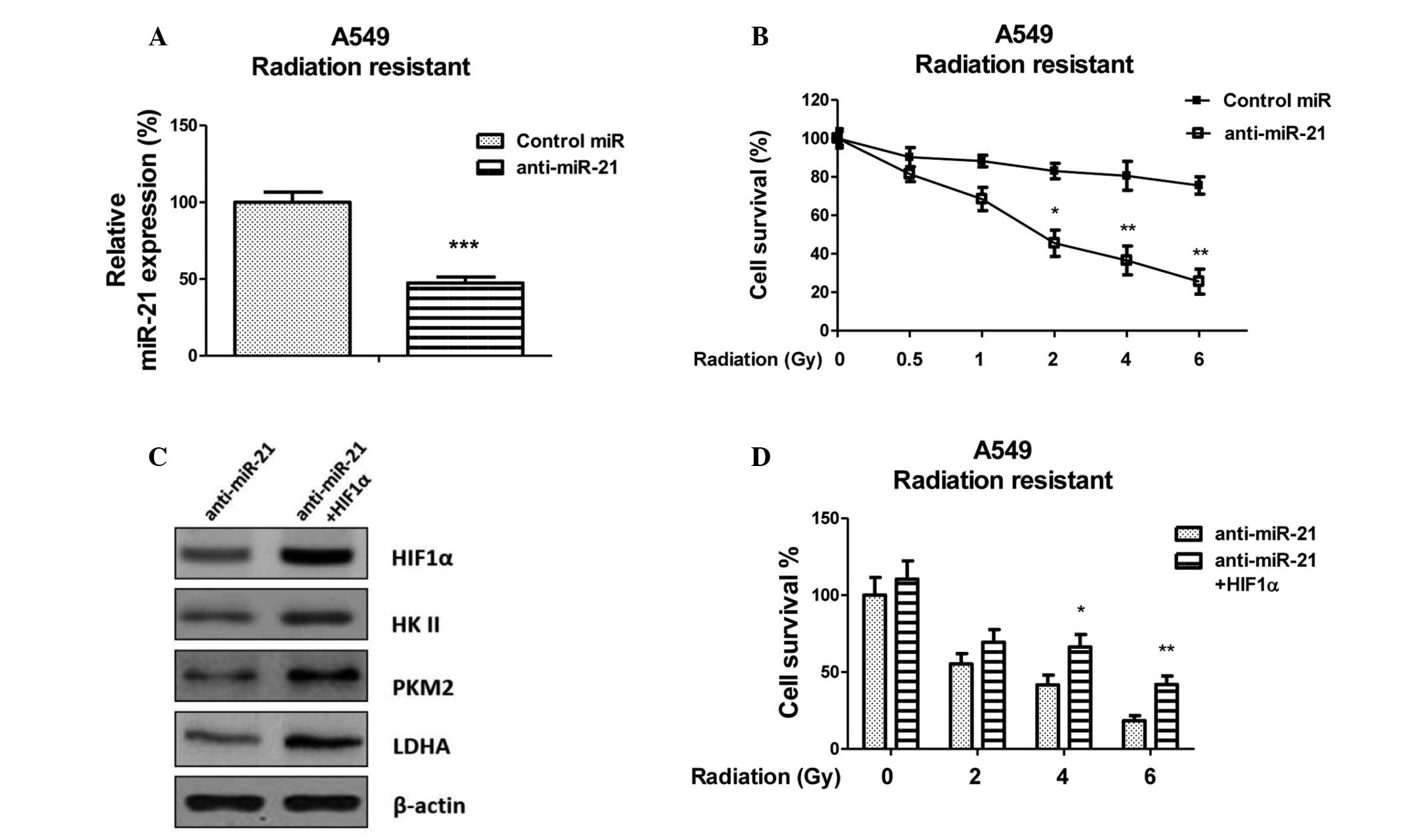MicroRNA-21 modulates radiation resistance through upregulation of hypoxia-inducible factor-1α-promoted glycolysis in non-small cell lung cancer cells
- Authors:
- Published online on: March 18, 2016 https://doi.org/10.3892/mmr.2016.5010
- Pages: 4101-4107
Abstract
Introduction
MicroRNAs (miRNAs) are functional non-coding RNAs, 20–24 nucleotides long, which have important roles in the regulation of the stability and translational efficiency of target mRNAs (1). Mature miRNAs induce post-transcriptional gene silencing by targeting the complementary sequence motifs within the 3′-untranslated regions of target mRNAs. Therefore, aberrant miRNA expression may affect the transcription of target genes and profoundly influence cancer-associated signaling pathways, which are involved in proliferation, cell cycle control, apoptosis, differentiation, migration and metabolism (2,3). Tumor tissue usually exhibits reduced levels of mature miRNAs (4); however, miRNA (miR)-21 has been reported to act as an oncomiR, which is highly expressed and correlated with numerous types of cancer, including pancreatic (5), breast (6), non-small cell lung (7), liver (8), gastric (9), ovarian (10), cervical (11), colon (12), brain (13), esophageal (14) and prostate (15) cancer. In addition, a previous study demonstrated that miR-21 modulated paclitaxel sensitivity in ovarian cancer (16), indicating that miR-21 has an important role in chemoresistance.
Ionizing radiation is used extensively to treat various types of cancer. However, despite the wide use of radiation therapy and its association with remission, tumor recurrence is a predominant cause of radiation treatment failure, and is frequently associated with the acquisition of radioresistance by tumors (17). At present, the detailed mechanism underlying radiation resistance in human cancer remains unclear. It has previously been reported that upregulated phopshoinositide 3-kinase/AKT signaling may render human liver and cervical cancer resistant to radiation (17,18). In addition, a previous study demonstrated that high expression levels of miR-21 may contribute to radiation resistance in breast cancer cells (19), thus suggesting that targeting miR-21 may be considered a therapeutic strategy to overcome radiation resistance.
The majority of cancer cells prefer anaerobic glycolysis for the production of their energy supply, which is known as the 'Warburg effect'; however, anaerobic glycolysis is less efficient at producing ATP, as compared with mitochondrial respiration (20). As a result, uptake of excessive glucose and generation of large quantities of lactate by cancer cells is a well-recognized phenotype of abnormal glycolysis. Notably, previous studies have suggested that metabolic pathways are associated with chemoresistance (17,18,21), suggesting that dysregulated metabolic pathways in cancer may be a target for the development of novel therapeutic strategies. The present study identified the role of miR-21 in radiation resistance. The results detected a correlation between glycolysis and radioresistance, and may provide evidence regarding the mechanisms underlying miR-21-mediated radioresistance in non-small cell lung cancer cells.
Materials and methods
Cell culture and ionizing radiation treatment
The A549 lung cancer cells were obtained from the American Type Culture Collection (Manassas, VA, USA) and cultured in RPMI-1640 media (Gibco; Thermo Fisher Scientific, Inc., Waltham, MA, USA) supplemented with 10% fetal bovine serum (Thermo Fisher Scientific, Inc.) and antibiotics (Gibco Antibiotic-Antimycotic containing mphotericin B, penicillin and streptomycin; Gibco, Thermo Fisher Scientific, Inc.) at 37°C in a humidified incubator containing 5% CO2. The cells, at a density of 5×105, were exposed to various doses of irradiation (0, 0.5, 1, 2, 4, 5, 6, 8 and 10 Gy) using a Cs-137 irradiator (HWM D-2000; Siemens, Waltershausen, Germany) at a dose rate of 2 Gy/min. Irradiation was administered at room temperature and the cells were subsequently incubated at 37°C, and harvested for the following experiments.
Antibodies
The following antibodies were used in the present study: Anti-hexokinase 2 (HKII) (cat. no. 2867), anti-pyruvate kinase (PK)M2 (cat. no. 4053), anti-lactate dehydrogenase (LDH)A (cat. no. 2012), anti-β-actin (cat. no. 4967) (Cell Signaling Technology, Inc., Danvers, MA, USA), and anti-hypoxia-inducible factor (HIF)1α (cat. no. sc-10790; Santa Cruz Biotechnology, Inc., Dallas, TX, USA).
Small interfering (si)RNA and plasmid DNA transfection
HIF-1α siRNA sequences (cat. no. 106498) and negative control siRNA were purchased from Ambion (Thermo Fisher Scientific, Inc.). Cells were seeded onto 6-well plates at a density of 1×105 cells/well. A plasmid vector containing wild type HIF1α was purchased from Addgene (Cambridge, MA, USA). Transfection was performed using Lipofectamine® 2000 and Opti-MEM I reduced serum medium (Invitrogen; Thermo Fisher Scientific, Inc.), according to the manufacturer's protocol. Transfection temperature was 37°C, and the volume of siRNA/vector and Lipofectamine used was 100 nM siRNA/vector and 5 µl Lipofectamine, respectively for each transfection. A total of 48 hours post-transfection, the cells were prepared for further analysis.
miRNA transfection
The precursor and antisense sequences of miR-21 were chemically synthesized by GenePharma Co., Ltd. (Shanghai, China). The cells were seeded in 6-well plates at 1×105 cells/well and cultured overnight. Subsequently, the cells were transfected with 200 nM pre-miR-21, inhibitors or negative control, using Lipofectamine® 2000 and Opti-MEM I reduced serum medium (Invitrogen), according to the manufacturer's protocol. A total of 48 hours post transfection, the cells were prepared for further analysis.
Cell viability assay
The cells were seeded into 96-well culture plates at a density of 5×103. Following cellular adhesion, the cells were exposed to various doses of irradiation. Following irradiation, 20 µl 5 mg/ml 3-(4,5-dimethylthiazol-2-yl)-2,5-di-phenyltetrazolium bromide (MTT; Sigma-Aldrich, St. Louis, MO, USA) was added to each well. Following a 4 h incubation at 37°C, the medium was gently aspirated and replaced with 150 µl dimethylsulfoxide. The absorbance of each well was detected at a wavelength of 570 nm using an ELx800 Absorbance Reader (BioTek Instruments, Inc., Winooski, VT, USA). The experiment was conducted in triplicate.
RNA extraction and reverse transcription-quantitative polymerase chain reaction (RT-qPCR)
Total RNA was extracted from the cells using the Absolutely RNA RT-PCR Miniprep kit (Agilent Technologies, Inc., Santa Clara, CA, USA), according to the manufacturer's protocol. Total RNA concentration was adjusted to 2 ng/µl using a NanoDrop 2000 spectrophotometer (Thermo Fisher Scientific, Inc.). Total RNA (1 µg) was reverse transcribed using the High Capacity cDNA Reverse Transcription kit (Applied Biosystems; Thermo Fisher Scientific, Inc.). The cDNA was then diluted to 1:10 for use as a template for RT-qPCR. PCR amplifications were performed in a final reaction volume of 10 µl containing: 5.5 µl TaqMan Universal PCR Master mix (Applied Biosystems), 0.5 µl primers and probes mix and 4.5 µg cDNA. The cycling conditions were as follows: One cycle at 50°C for 2 min, one cycle at 95°C for 10 min, followed by 40 cycles of denaturation (95°C for 15 sec), and a final annealing/extension step at 60°C for 1 min. All reactions were conducted using the Step One Plus Real-Time PCR Systems Thermocycler (Applied Biosystems). All quantitative PCR reactions were carried out in triplicate and repeated at least twice. The ΔCquantification (ΔCq) for mRNA expression was calculated relative to the Cq of 18S ribosomal RNA. Relative mRNA expression was calculated using the formula 2(−ΔΔCq). The primers used for qPCR were as follows: LDHA, forward ATCTTGACCTACGTGGCTTGGA and reverse CCATACAGGCACACTGGAATCTC; HKII, forward CAAAGTGACAGTGGGTGTGG and reverse GCCAGGTCCTTCACTGTCTC; and PKM2, forward GAGGCCTCCTTCAAGTGCT and reverse CCAGACTTGGTGAGGACGAT. RT-qPCR quantification using the TaqMan-miRNA assay (Applied Biosystems) was conducted to determine the expression levels of miR-21 (cat. no. 4427975; assay ID 000397), using the cycling conditions previously described. qPCR was performed using the Step One Plus Detection system (Applied Biosystems), according to the manufacturer's protocol. The relative expression values of the specific miRNA were calculated using the 2−ΔΔCq method, normalized to the control miRNA (GAPDH: 5′-AATCCCATCACCATCTTCCA-3′ forward and 5′-TGGACTCCACGACGTACTCA-3′ reverse). All reactions were performed at least twice in duplicate.
Measurements of glucose consumption and lactate production
The cells were seeded in 6-well plates at a density of 5×105 cells/well in 3 ml culture medium. Then, conditioned medium and distilled water were mixed at a 1:20 ratio (conditioned medium:distilled water. The glucose concentration in the diluted medium was measured using the Glucose Assay kit (Sigma-Aldrich), according to the manufacturer's protocol. Glucose consumption was calculated by subtracting the concentration of glucose remaining in the medium 24 h later from the concentration of glucose present in the fresh cell culture medium. Lactate concentrations were determined using a Lactate Assay kit (BioVision, Mountain View, CA, USA) according to the manufacturer's protocol. Samples and a lactate standard were prepared with lactate assay buffer in a 96-well plate. Subsequently, 50 µl lactate enzyme mix was added to each well, and incubated for 30 min at room temperature. Optical density values were measured at 570 nm using a microplate reader (SpectraMax M2e; Molecular Devices, LLC, Sunnyvale, CA, USA). The results were normalized to the amount of total protein, as compared with the control cells.
Western blot analysis
The cells were harvested and washed with ice-cold phosphate-buffered saline (PBS). Cell lysates were obtained by re-suspending the cells in radioimmunoprecipitation assay buffer [10 mM Tris (pH 7.4), 150 mM NaCl, 1% Triton X-100, 1% Na-deoxycholate (Kanto Chemical Co., Inc., Tokyo, Japan)] and 5 mM EDTA supplemented with protease inhibitor cocktail (Sigma-Aldrich). The protein concentration of the cell lysates was determined by Bradford assay, using a Bradford kit (Beyotime Institute of Biotechnology, Shanghai, China). Equal quantities of protein (1 µg/µl) were separated by 10% homemade sodium dodecyl sulfate-poly-acrylamide gel electrophoresis and electrotransferred onto a polyvinylidene difluoride membrane (Bio-Rad Laboratories, Inc., Hercules, CA, USA). The membranes were blocked with 5% non-fat milk and incubated overnight with primary antibodies at 4°C at a dilution of 1:1,000. The membranes were then washed with PBS with Tween 20 and incubated at room temperature for 1 h with horseradish peroxidase-conjugated goat anti-rabbit immunoglobulin G secondary antibodies (cat. no., 7074; dilution, 1:3,000; Nichirei Biosciences, Inc., Tokyo, Japan). Protein bands were visualized using Chemi-Lumi One L Western Blotting Substrate (Nacalai Tesque, Kyoto, Japan).
Statistical analysis
Statistical analysis was performed using Prism 5.0 (GraphPad Software, Inc., La Jolla, CA, USA) and the unpaired Student's t-test was used to analyze the data. All data are presented as the mean ± standard error. P<0.05 was considered to indicate a statistically significant difference.
Results
miR-21 expression levels are higher in radiation-resistant lung cancer cells
To investigate the association between miR-21 expression and radiation sensitivity, a radiation-resistant non-small cell lung cancer cell line was generated using A549 parental cells, according to a previous study (22). The cells were treated with increasing doses of radiation for 4 months, in order to generate resistant cells. Resistant cell clones were developed and pooled. To confirm that the cells were radioresistant, the A549 parental cells and resistant cells underwent various doses of irradiation. A total of 72 h post-irradiation cellular proliferation was determined using an MTT assay (Fig. 1A). The A549 radiation-resistant cells were able to tolerate higher intensities of radiation. In addition, the expression levels of miR-21 were significantly upregulated in the radiation-resistant cells, as compared with the sensitive cells (Fig. 1B), thus suggesting that miR-21 may contribute to radioresistance in non-small lung cancer. To confirm the above observation, A549 cells were transiently transfected with pre-miR-21, in order to overexpress miR-21. The radiation sensitivity of A549 cells with and without overexpression of miR-21 were subsequently measured following treatment with the indicated doses. The A549 cells had an increased survival capacity in response to irradiation following transfection with miR-21 (Fig. 1C). These data indicate a strong correlation between miR-21 and radioresistance in lung cancer cells, suggesting that miR-21 may be a target for overcoming radiation resistance.
Radioresistant lung cancer cells exhibit upregulated glycolysis
Enhanced anaerobic glycolysis often accompanies radioresistance in cancer. To determine the mechanisms underlying miR-21-promoted radioresistance, the glycolysis rates of radiation-sensitive and -resistant A549 cells were detected. The glucose consumption and lactate production were determined. As shown in Fig. 2A, glucose consumption and lactate production were promoted in the radiation-resistant cells, thus indicating that upregulated anaerobic glycolysis may be associated with the radioresistance. In addition, the expression levels of glycolysis-associated enzymes were detected. The protein and mRNA expression levels of HKII, PKM2 and LDHA were upregulated in the radioresistant cells (Fig. 2B and C). These results suggest that enhancement of glycolysis by miR-21 is mediated via upregulation of glycolysis-associated enzymes at the transcriptional level.
miR-21 promotes glycolysis via upregulation of HIF1α
To further explore the mechanisms underlying the miR-21-mediated transcriptional regulation of the key enzymes of glycolysis in radiation-resistant cells, a literature search was conducted, focusing on HIF1α, which is a heterodimeric transcription factor induced by hypoxia, growth factors and oncogenes. It has previously been reported that under hypoxic conditions HIF1α may be activated and stimulate the transcription of downstream target genes, including LDHA and HKII (23). In the present study, it was hypothesized that HIF1α may be activated in radioresistant cells, and have an important role in radioresistance by promoting the expression of downstream glycolytic enzymes. To determine whether miR-21 affects HIF1α expression, the A549 radiation-sensitive and -resistant cells were transfected with an miR-21 precursor or control miRNA, and the expression levels of HIF1α and glycolytic key enzymes were detected, and glucose consumption and lactate production were measured. As hypothesized, overexpression of miR-21 significantly increased the expression levels of HIFα and the key enzymes of glycolysis (Fig. 3A). Consistently, glucose consumption and lactate production were increased following miR-21 transfection (Fig. 3B). To confirm that miR-21 promotes the glycolysis of non-small cell lung cancer cells through the upregulation of HIF1α, HIF1α expression was silenced in the miR-21-pretransfected cells using siRNA (Fig. 3C). Glucose consumption and lactate production were downregulated following inhibition of HIF1α (Fig. 3D). These results indicate that miR-21-regulated HIF1α may be associated with the underlying mechanism of radioresistance.
Suppression of glycolysis by inhibiting miR-21 sensitizes lung cancer cells to radiation
To determine whether miR-21 inhibition was able to enhance the radiosensitivity of lung cancer cells, A549 cells were transfected with anti-sense oligonucleotides targeting miR-21 or a scrambled miRNA control (Fig. 4A). Glycolysis was measured 48 h post-transfection. Inhibition of miR-21 decreased glycolysis, as detected by measuring glucose consumption and lactate production (Fig. 4B and C). In addition, A549 cells transfected with anti-miR-21 or control miRNA were exposed to various doses of radiation (0, 0.5, 1, 2, 4 and 6 Gy) at a rate of 2 Gy/min, and a cell survival assay was performed. The survival fraction of the anti-miRNA-21-transfected cells was significantly decreased, as compared with the control group (Fig. 4D). These results indicate a correlation between miR-21 expression and the radiosensitivity of A549 cells to γ-radiation.
Inhibition of miR-21 resensitizes lung cancer cells to radiation through HIF1α regulation
To further investigate whether miR-21 is capable of modulating the sensitivity of radioresistant lung cancer cells, the A549 radioresistant cells were transfected with anti-miR-21 or a negative control (Fig. 5A). Inhibition of miR-21 significantly increased the susceptibility of the radioresistant cells to irradiation, as compared with the negative control-transfected cells. The half maximal inhibitory concentration (IC50) of the anti-miR-21-transfected A549 cells was 2 Gy, which was lower than the IC50 of the negative control-transfected A549 cells, which was 15 Gy (Fig. 5B). To determine the correlation between HIF-1α and anti-miR-21-induced sensitivity, the anti-miR-21-transfected A549 radioresistant cells were transiently transfected with an overexpression vector containing wild type HIF-1α, in order to rescue its function. With the restoration of HIF1α, the expression levels of the key enzymes of glycolysis were rescued (Fig. 5C). In addition, the sensitivity of HIF1α-transfected radioresistant cells to various doses of radiation was determined. As shown in Fig. 5D HIF1α-transfected A549 radioresistant cells regained resistance to radiation. These results suggest that inhibition of miR-21 modulates the sensitivity of A549 radioresistant cells to irradiation via the downregulation of HIF1α.
Discussion
The present study demonstrated the importance of miR-21-mediated enhanced aerobic glycolysis on acquired radioresistance in non-small cell lung cancer cells. Cancer cells use anaerobic glycolysis to assist in their growth, and a shift toward anaerobic glycolysis occurs with active suppression of oxidative phosphorylation, which results from aberrant regulation of glycolytic enzymes. The present study demonstrated that glycolysis was upregulated in radioresistant cancer cells, suggesting that specific inhibition of glycolysis may contribute to overcoming radioresistance. It has previously been reported that ionizing radiation and various chemotherapeutic drugs induce oxidative stress in targeted cells, leading to genomic instability and lipid peroxidation (24). In addition, excessive lactate production in cancer cells via glycolysis has been reported to act as an antioxidant (25). Therefore, an accumulation of lactate in the tumor microenvironment may jeopardize the sensitivity of cancer cells to radiation and cause chemoresistance.
Upregulation of miR-21 has been detected in numerous types of human cancer. It has previously been reported that miR-21 expression is higher in lung cancer serum samples compared with normal tissues, and high serum miR-21 levels are significantly correlated with lung tumors (19). Furthermore, miR-21 is involved in chemoresistance and radioresistance. A previous study demonstrated that miR-21 was upregulated in human liver cancer following exposure to radiation (26). In human ovarian cancer cells, miR-21 has been show to modulate paclitaxel sensitivity (16). The present study detected miR-21 expression in radiation-resistant and radiation-sensitive non-small cell lung cancer cells following exposure to γ-irradiation. The results demonstrated that miR-21 was upregulated in radioresistant non-small cell lung cancer cells, and inhibition of miR-21 led to resensitization of the radioresistant cells to irradiation, which was consistent with a previous study (19). These data support the hypothesis that miR-21 is not only associated with oncogenesis, but can act as a radioresistant miRNA, which may be considered a therapeutic target for the development of anticancer drugs.
The putative target of miR-21 was screened and HIF1α was demonstrated to be a potential target. HIF1α is a multifunctional transcription factor that has been shown to regulate glucose metabolism in a growth factor-dependent manner (23). Previous studies have demonstrated that HIF1α may contribute to the development of radioresistance (27). As HIF1α is an upstream signaling molecule of glycolysis, upregulation of HIF1α promotes glycolysis (23). The results of the present study revealed that HIF1α was upregulated by miR-21, resulting in the promotion of the key enzymes of glycolysis. Inhibition of HIF1α by siRNA suppressed glycolysis and resensitized the cancer cells to radiation, thus suggesting that miR-21-induced radioresistance was mediated through the upregulation of HIF1α. However, the detailed mechanisms underlying the miR-21-mediated regulation of HIF1α remain unclear. In our next project, we aim to investigate this phenotype, and to determine by which pathway miR-21 regulates HIF1α.
In conclusion, the present study detected a strong correlation between the upregulation of miR-21 and radio-resistance in non-small cell lung cancer cells. In addition, overexpression of miR-21 activated HIF1α, which stimulated the expression of glycolytic enzymes. Notably, inhibition of miR-21 resensitized radioresistant cancer cells, via the suppression of HIF1α-mediated glycolysis. The present study may provide evidence regarding the targeting of miRNAs for the resensitization of radiation-resistant cancer cells.
Acknowledgments
The authors of the present study would like to thank the staff and faculty working in the Department of Radiation Oncology, Shandong Cancer Hospital and Institute (Jinan, China), and Dr. Hongjiang Yan for editorial assistance. The present study was supported by a grant from the Science and Technology Department of Shandong Province of China (grant no. 2012YD18087).
References
|
Ha M and Kim VN: Regulation of microRNA biogenesis. Nat Rev Mol Cell Biol. 15:509–524. 2014. View Article : Google Scholar : PubMed/NCBI | |
|
Brodersen P and Voinnet O: Revisiting the principles of microRNA target recognition and mode of action. Nat Rev Mol Cell Biol. 10:141–148. 2009. View Article : Google Scholar : PubMed/NCBI | |
|
Ameres SL and Zamore PD: Diversifying microRNA sequence and function. Nat Rev Mol Cell Biol. 14:475–488. 2013. View Article : Google Scholar : PubMed/NCBI | |
|
Jansson MD and Lund AH: MicroRNA and cancer. Mol Oncol. 6:590–610. 2012. View Article : Google Scholar : PubMed/NCBI | |
|
Sicard F, Gayral M, Lulka H, Buscail L and Cordelier P: Targeting miR-21 for the therapy of pancreatic cancer. Mol Ther. 21:986–994. 2013. View Article : Google Scholar : PubMed/NCBI | |
|
Iorio MV, Ferracin M, Liu CG, Veronese A, Spizzo R, Sabbioni S, Magri E, Pedriali M, Fabbri M, Campiglio M, et al: MicroRNA gene expression deregulation in human breast cancer. Cancer Res. 65:7065–7070. 2005. View Article : Google Scholar : PubMed/NCBI | |
|
Ma Y, Xia H, Liu Y and Li M: Silencing miR-21 sensitizes non-small cell lung cancer A549 cells to ionizing radiation through inhibition of PI3K/Akt. Biomed Res Int. 2014:6178682014. View Article : Google Scholar : PubMed/NCBI | |
|
Pineau P, Volinia S, McJunkin K, Marchio A, Battiston C, Terris B, Mazzaferro V, Lowe SW, Croce CM and Dejean A: miR-221 overexpression contributes to liver tumorigenesis. Proc Natl Acad Sci USA. 107:264–269. 2010. View Article : Google Scholar : | |
|
Chan SH, Wu CW, Li AF, Chi CW and Lin WC: miR-21 microRNA expression in human gastric carcinomas and its clinical association. Anticancer Res. 28:907–911. 2008.PubMed/NCBI | |
|
Iorio MV, Visone R, Di Leva G, Donati V, Petrocca F, Casalini P, Taccioli C, Volinia S, Liu CG, Alder H, et al: MicroRNA signatures in human ovarian cancer. Cancer Res. 67:8699–8707. 2007. View Article : Google Scholar : PubMed/NCBI | |
|
Yao T and Lin Z: MiR-21 is involved in cervical squamous cell tumorigenesis and regulates CCL20. Biochim Biophys Acta. 1822:248–260. 2012. View Article : Google Scholar | |
|
Kanaan Z, Rai SN, Eichenberger MR, Roberts H, Keskey B, Pan J and Galandiuk S: Plasma miR-21: A potential diagnostic marker of colorectal cancer. Ann Surg. 256:544–551. 2012. View Article : Google Scholar : PubMed/NCBI | |
|
Chan JA, Krichevsky AM and Kosik KS: MicroRNA-21 is an antiapoptotic factor in human glioblastoma cells. Cancer Res. 65:6029–6033. 2005. View Article : Google Scholar : PubMed/NCBI | |
|
Fu C, Dong W, Wang Z, Li H, Qin Q and Li B: The expression of miR-21 and miR-375 predict prognosis of esophageal cancer. Biochem Biophys Res Commun. 446:1197–1203. 2014. View Article : Google Scholar : PubMed/NCBI | |
|
Folini M, Gandellini P, Longoni N, Profumo V, Callari M, Pennati M, Colecchia M, Supino R, Veneroni S, Salvioni R, et al: miR-21: An oncomir on strike in prostate cancer. Mol Cancer. 9:122010. View Article : Google Scholar : PubMed/NCBI | |
|
Xie Z, Cao L and Zhang J: miR-21 modulates paclitaxel sensitivity and hypoxia-inducible factor-1α expression in human ovarian cancer cells. Oncol Lett. 6:795–800. 2013.PubMed/NCBI | |
|
Fang J, Zhou SH, Fan J and Yan SX: Roles of glucose transporter-1 and the phosphatidylinositol 3-kinase/protein kinase B pathway in cancer radioresistance (review). Mol Med Rep. 11:1573–1581. 2015. | |
|
Shimura T, Noma N, Sano Y, Ochiai Y, Oikawa T, Fukumoto M and Kunugita N: AKT-mediated enhanced aerobic glycolysis causes acquired radioresistance by human tumor cells. Radiother Oncol. 112:302–307. 2014. View Article : Google Scholar : PubMed/NCBI | |
|
Wang XC, Wang W, Zhang ZB, Zhao J, Tan XG and Luo JC: Overexpression of miRNA-21 promotes radiation-resistance of non-small cell lung cancer. Radiat Oncol. 8:1462013. View Article : Google Scholar : PubMed/NCBI | |
|
Vander Heiden MG, Cantley LC and Thompson CB: Understanding the Warburg effect: The metabolic requirements of cell proliferation. Science. 324:1029–1033. 2009. View Article : Google Scholar : PubMed/NCBI | |
|
Ganapathy-Kanniappan S and Geschwind JF: Tumor glycolysis as a target for cancer therapy: Progress and prospects. Mol Cancer. 12:1522013. View Article : Google Scholar : PubMed/NCBI | |
|
Young A, Berry R, Holloway AF, Blackburn NB, Dickinson JL, Skala M, Phillips JL and Brettingham-Moore KH: RNA-seq profiling of a radiation-resistant and radiation sensitive prostate cancer cell line highlights opposing regulation of DNA repair and targets for radiosensitization. BMC Cancer. 14:8082014. View Article : Google Scholar | |
|
Lu H, Forbes RA and Verma A: Hypoxia-inducible factor 1 activation by aerobic glycolysis implicates the Warburg effect in carcinogenesis. J Biol Chem. 277:23111–23115. 2002. View Article : Google Scholar : PubMed/NCBI | |
|
Azzam EI, Jay-Gerin JP and Pain D: Ionizing radiation-induced metabolic oxidative stress and prolonged cell injury. Cancer Lett. 327:48–60. 2012. View Article : Google Scholar | |
|
Le A, Cooper CR, Gouw AM, Dinavahi R, Maitra A, Deck LM, Royer RE, Vander Jagt DL, Semenza GL and Dang CV: Inhibition of lactate dehydrogenase A induces oxidative stress and inhibits tumor progression. Proc Natl Acad Sci USA. 107:2037–2042. 2010. View Article : Google Scholar : PubMed/NCBI | |
|
Liang G, Li G, Wang Y, Lei W and Xiao Z: Aberrant miRNA expression response to UV irradiation in human liver cancer cells. Mol Med Rep. 9:904–910. 2014.PubMed/NCBI | |
|
Harada H, Inoue M, Itasaka S, Hirota K, Morinibu A, Shinomiya K, Zeng L, Ou G, Zhu Y, Yoshimura M, et al: Cancer cells that survive radiation therapy acquire HIF-1 activity and translocate towards tumour blood vessels. Nat Commun. 3:7832012. View Article : Google Scholar : PubMed/NCBI |



